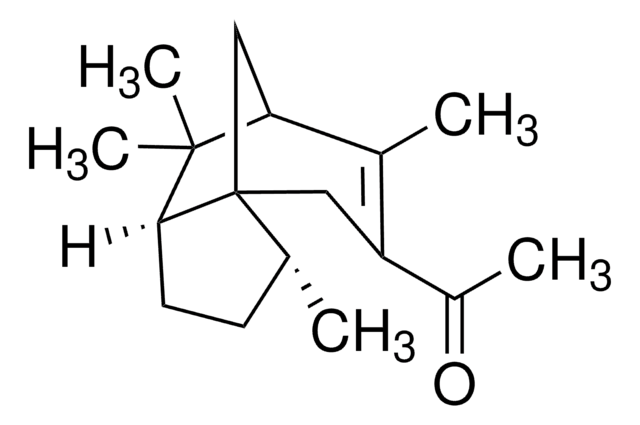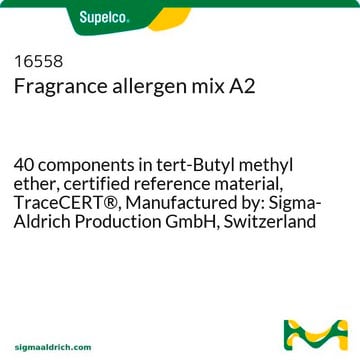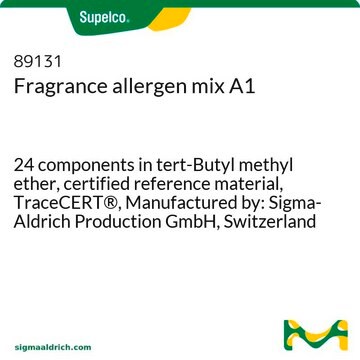44064
3-Methyl-5-(2,2,3-trimethyl-3-cyclopenten-1-yl)-4-penten-2-ol
analytical standard
Synonym(s):
Ebanol
Sign Into View Organizational & Contract Pricing
All Photos(1)
About This Item
Empirical Formula (Hill Notation):
C14H24O
CAS Number:
Molecular Weight:
208.34
Beilstein:
11329261
UNSPSC Code:
85151701
NACRES:
NA.24
Recommended Products
grade
analytical standard
Quality Level
Assay
≥90% (GC)
shelf life
limited shelf life, expiry date on the label
application(s)
cleaning products
cosmetics
food and beverages
personal care
format
neat
InChI
1S/C14H24O/c1-10(12(3)15)6-8-13-9-7-11(2)14(13,4)5/h6-8,10,12-13,15H,9H2,1-5H3/b8-6-
InChI key
RNLHVODSMDJCBR-VURMDHGXSA-N
Looking for similar products? Visit Product Comparison Guide
Related Categories
General description
3-Methyl-5-(2,2,3-trimethyl-3-cyclopenten-1-yl)-4-penten-2-ol, a derivative of α-campholenic aldehyde, is a synthetic alternative for sandalwood oil − a key perfume ingredient.
Application
3-Methyl-5-(2,2,3-trimethyl-3-cyclopenten-1-yl)-4-penten-2-ol may be used as an analytical standard for the determination of the analyte in sandalwood oil (Santalum album L.), cosmetics and personal care products, and biological samples of the animals exposed to the sandalwood odorants by gas chromatography (GC) based techniques.
Hazard Statements
Precautionary Statements
Hazard Classifications
Aquatic Chronic 2
Storage Class Code
10 - Combustible liquids
WGK
WGK 2
Flash Point(F)
226.4 °F
Flash Point(C)
108 °C
Choose from one of the most recent versions:
Already Own This Product?
Find documentation for the products that you have recently purchased in the Document Library.
Four-stage (low-) flow modulation comprehensive gas chromatography? quadrupole mass spectrometry for the determination of recently-highlighted cosmetic allergens
Tranchida PQ, et al.
Journal of Chromatography A, 1439(1), 144-151 (2016)
Olfactory receptor neuron profiling using sandalwood odorants
Bieri S, et al.
Chemical Senses, 29(6), 483-487 (2004)
Authenticity of essential oils
Do TKT, et al.
TrAC, Trends in Analytical Chemistry, 66(6), 146-157 (2015)
The survey of analytical methods for sample preparation and analysis of fragrances in cosmetics and personal care products
Abedi G, et al.
TrAC, Trends in Analytical Chemistry, 102(1), 41-59 (2018)
Danilo Sciarrone et al.
Journal of chromatography. A, 1218(1), 137-142 (2010-11-30)
The production and trade of Indian sandalwood oil is strictly regulated, due to the impoverishment of the plantations; for such a reason, Australian sandalwood oil has been evaluated as a possible substitute of the Indian type. International directives report, for
Our team of scientists has experience in all areas of research including Life Science, Material Science, Chemical Synthesis, Chromatography, Analytical and many others.
Contact Technical Service









